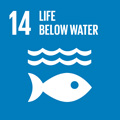- Docente: Alessia Cariani
- Credits: 6
- SSD: BIO/05
- Language: Italian
- Moduli: Alessia Cariani (Modulo 1) Alessia Cariani (Modulo 2)
- Teaching Mode: In-person learning (entirely or partially) (Modulo 1); In-person learning (entirely or partially) (Modulo 2)
- Campus: Bologna
- Corso: First cycle degree programme (L) in Biological Sciences (cod. 8012)
Learning outcomes
At the end of the course, the student will know the different aspects of the life cycle of marine species that constitute 'case studies', particularly with regard to the fisheries resources and the main methods of analysis for taxa representative of the domains marine (plankton, benthos, nekton) in relation the evolutionary and adaptive traits. The student is also able to design a study concerning certain significant phases of the life cycle, such as reproduction, growth, feeding.
Course contents
1) Animal biodiversity in marine domains (benthos, plankton, nekton) in relation to evolutive and adaptive traits and recent climate and global changes.
2) Benthos: animals dwelling the seabed. The vertical distribution and the main communities: the littoral system and the diversification of the superficial surfaces), intertidal, infralittoral, circalittoral of the Mediterranean Sea. Animal adaptations in relation to the substrate, depth, latitude. Representative taxa. Marine bioconstructions: barrier builders.
3) Plankton: Animals floating in the water column. Adaptations: shapes, buoyancy, colors. Classification: dimensional criteria related to their life cycles. Oloplancton: representative taxa. Meroplankton: the larvae. Spatial distribution of zooplankton; Bipolar species. Vertical migrations. The power supply. The role of zooplankton in the cycle of matter. Animals living into the air-water interface.
4) Nekton: animals actively swimming in the water column. Representative taxa. Adaptation to swim and adaptive convergences. Invisible barriers.
5) Sea vertebrates partially linked to emerging lands: adaptations and diversity.
6) Animal life in extreme environments:
the deepest sea: the deep system, and bathyal, abyssal planes. Adaptations, food shortages and reproductive strategies;
Arctic and Antarctic poles: adaptations to cold;
Transition environments: adaptations to the instability of environmental-chemical parameters.
Readings/Bibliography
Cognetti Sarà Magazzù "Biologia Marina" Ed. Edagricole-New Business Media 2010
Castro Huber "Biologia Marina" Ed. McGraw-Hill
Danovaro "Biologia marina. Biodiversità e funzionamento degli ecosistemi marini” Ed. UTET
Hickman, Keen, Eisenhour, Larson, Lanson, Arizza, Coppellotti, Guidolin “Zoologia” Ed. Mc Graw Hill
Casiraghi de Eguileor Cerrano Puce “Zoologia” Ed. UTET
Teaching material and scientific papers proposed and provided by academic lecturers
Teaching methods
Lectures with PowerPoint projection and scientific films related to adaptations and life processes of representative fauna of marine domains and extreme environments. Observation and sorting of macroscopic and microscopic samples of marine taxa living in the water column and the coastal zone with different geographic origin. Observation of preserved animals.
Assessment methods
Oral exam on the program with recognition of micro and macroscopic marine animals.
Teaching tools
Slide presentations
Lab-tutorials and digital handbook for practicals
Peer-review scientific papers
Office hours
See the website of Alessia Cariani
SDGs

This teaching activity contributes to the achievement of the Sustainable Development Goals of the UN 2030 Agenda.
